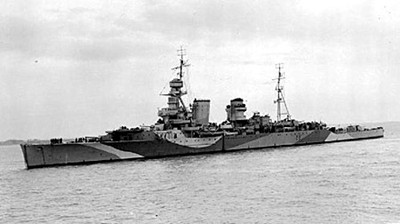|
The D-Day landing AN EYE WITNESS ACCOUNT
A remarkable document detailing the early hours of the D-Day landing in June 1944 has survived in the scrapbook of a former Bourne man who took part in the historic operation seventy years ago. Derek Smith, a retired corn merchant, now aged 92, was a rating working as a coder in communications serving aboard the cruiser HMS Hawkins which sailed from Portsmouth as part of the 14th Task Force involved in Operation Neptune, the amphibious phase of D-Day and provided the off shore gunfire bombardment while the landings took place at Utah Beach. The document is a mere scrap of foolscap paper but contains the official detailed account written in typescript of how action stations were manned aboard the ship from 6.30 am on the morning of Tuesday 6th June and then a log of how the various gun batteries opened up for the bombardment which continued until 8.40 pm three days later. It tells how the 2.5 inch, 6.1 inch and 6.6 inch guns gradually started firing salvoes as the landing got underway, recording hits in the various target areas with Spitfires dive-bombing enemy shore batteries and heavy mobile artillery. One American ship, the USS Glennon, which was providing protection for invasion shipping and naval gunfire support for assault troops, hit a mine and was immobilised while a destroyer going to her assistance suffered a similar fate. [The Glennon was later hit by German artillery fire which cut her power and forced her abandonment and she capsized and sank with the loss of 25 of her crew]. Targets were continually adjusted because of the close proximity of our own troops with German shore batteries returning fire. And so it went on for three days. The events of June 1944 remain vivid in Derek’s mind even today, seventy years after the operation. “The date of the bombardment was postponed for a day because of bad weather”, he said, “but once we started morale was high although we were aware of the dangers from mines and U boats. We saw several ships go down but we seemed to get through unscathed. After that we stayed off the Normandy coast for about a month as mother ship to the landing craft and then headed back to Portsmouth. It was an exciting time but very dangerous and we were all relieved when it was all over.” Once back at port, HMS Hawkins was decommissioned and Derek joined the crew of the aircraft carrier Victoria Castle which had been adapted to take the first jet aircraft before heading for the Indian Ocean where he spent the rest of the war. He finally left the navy in 1946 and came home to Bourne to work for Wherry and Sons as a representative but then took six months out to attend Glasgow University, returning home to begin his career in the grain trade. Derek had joined the Royal Navy in 1940 when he was 18 and remained with the service for over five years. He was one of three brothers who served, all having been born at No 23 North Road, Bourne and educated at Stamford School. The middle brother, Alan, was aboard the Duke of York when the German battleship Scharnhorst was sunk off the Norwegian coast in 1943 and the eldest, Billy, was among the 722 crew who lost their lives when the cruiser HMS Gloucester was sunk during the Battle of Crete in 1941 and his name is commemorated on the War Memorial in Bourne. Derek left Bourne when he was married in 1951 and now lives at Great Gonerby, near Grantham. His wife, Cynthia died three years ago, aged 91 after being married for sixty years. “The D-Day experience is something I shall never forget”, he said. “There were no heroics. We were just doing our duty and I think that everyone saw it that way.”
WRITTEN JUNE 2014
Go to: Main Index Villages Index |

